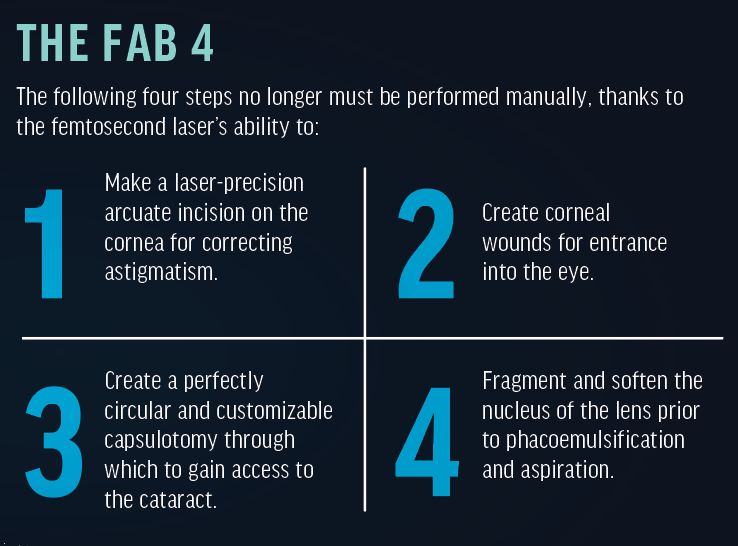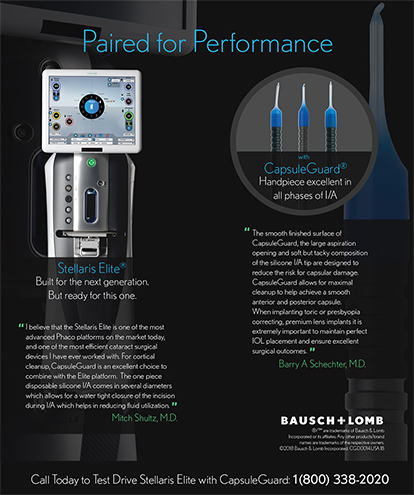During the past 50 years, cataract surgery has undergone a tremendous revolution. Starting out as a very invasive and risky procedure involving a lengthy hospital stay and the need for aphakic spectacles postoperatively, it is now a quick, safe, effective, and life-changing experience with the promise of freedom from glasses for the remainder of the patient’s life. Many technological advances have been critical to this process. Of these, one in particular has been instrumental in improving outcomes and reducing complications in my practice: femtosecond laser-assisted cataract surgery. Here’s how.
The Improvements
The femtosecond laser is able to perform four important steps of the cataract procedure that previously were done manually. Specifically, (from anterior to posterior), it can make a laser-precision arcuate incision on the cornea for correcting astigmatism, it can create corneal wounds to allow entrance into the eye, it creates a perfectly circular and customizable capsulotomy to gain access to the cataract, and it fragments and softens the nucleus of the lens prior to phacoemulsification and aspiration. Each one of these capabilities has had a major hand in automating the surgical procedure. These capabilities are discussed in more detail below.
Astigmatism Correction
Before the use of the femtosecond laser was an option, surgeons often used a diamond blade to make manual corneal incisions to correct low amounts of astigmatism. The depth of these incisions wasn’t always uniform and the location and the length of the arc were also prone to error. In contrast, with the femtosecond laser a precisely controlled depth, arc length, and optical zone incision can be performed exactly at the proper axis based on registration and imaging systems.
Corneal Wound Creation
By assigning it to a precise axis, location, length, width, and even shape, in terms of biplanar and triplanar design, the femtosecond laser can be used to create perfect corneal wounds.

Customized Capsulotomy
For the capsulorhexis or capsulotomy, it is no longer necessary to have perfect hand-eye coordination and require the patient to remain still during this delicate maneuver, during which the capsule is punctured and small forceps are used to peel a circular opening in the capsule. This has notoriously been one of the most challenging aspects of cataract surgery and is a step in which many complications are encountered, particularly when the tear runs out peripherally and damages the fragile capsule. This is no longer a concern with the femtosecond laser, as the laser is able to make a perfectly circular capsulotomy of a desired diameter and can be centered either on the pupil or on the visual axis, depending on the surgeon’s preference.
Prepping the Nucleus
Dense cataracts can pose a challenge for some surgeons, due to difficulty cracking the nucleus, removing the nucleus from the capsular bag, and avoiding potential damage to the corneal epithelium from excess heat and energy exposure from the phacoemulsification instrument. The femtosecond laser can be used to pretreat the cataract, softening it so that less phacoemulsification energy is needed to remove it, thereby reducing risk and complications.
Addressing the Downsides
Peer-reviewed literature published on the safety, effectiveness, and outcomes of this type of cataract surgery have been mixed. Some studies say that in skilled hands laser cataract surgery is no better than manual cataract surgery, while other studies show that it offers advantages to the patient.1,2
Peer-reviewed literature aside, in surgery, surgeon experience often tells the real story. I know of many surgeons who have embraced the technology and have experienced such success that they use it on as many patients as possible. Conversely, I have heard of only a few surgeons who felt their manual technique was better than the laser. The imaging systems of the lasers that drive the treatments, whether OCT or Scheimpflug-based, can identify and measure the anterior cornea, posterior cornea, anterior lens capsule, and posterior lens capsule.
These data provide surgeons with a tremendous amount of information about the eye and can alert them to potential anatomic abnormalities for appropriate planning.
Some surgeons have found a financial barrier to adopting this new technology, but many have been able to implement a femtosecond laser into their practices because it can be used to correct astigmatism. It should be noted that astigmatism correction is a noncovered service for which patients must pay an out-of-pocket fee. This helps offset some of the cost of the acquisition, operation, and maintenance of the laser.
A Stepping Stone to Progress
Surgeons who embrace laser cataract surgery often find themselves operating in a less stressful environment, in which many of the key steps of the procedure are automated and already performed for them prior to entering the eye. This results in less concentration and time required and reduces some of the risks commonly seen with the capsulorhexis and nucleus removal. Many surgeons are now finding more precise outcomes and the ability to deliver safer and higher quality vision for their patients. It’s hard to imagine that, with time, cataract surgery won’t mature into a more automated and even robotic procedure. The femtosecond laser is a key step toward that end.
- Chen X, Xiao W, Ye S, et al. Efficacy and safety of femtosecond laser-assisted cataract surgery versus conventional phacoemulsification for cataract: a meta-analysis of randomized controlled trials. Sci Rep. 2015;5:13123.
- Ang RET, Quinto MMS, Cruz EM, et al. Comparison of clinical outcomes between femtosecond laser-assisted versus conventional phacoemulsification. Eye Vis (Lond). 2018;5:8.






